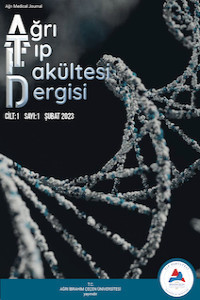Çocukluk Çağında Benign Trombositopeni ve Yeni TURBB1, ANKRD26 ve SAMD9 Varyantları
ÇOCUK, İdiyopatik trombositopenik purpura, moleküler genetik, trombositopeni
Benign Thrombocytopenia in Childhood and Novel TURBB1, ANKRD26, and SAMD9 Variants
___
- Bhatia I, Sharma A, Guleria S, et al. Thrombocytopenia in Children: A large prospective study on clinical manifestations, seasonal variation, etiology, and outcome. J Assoc Physicians India. 2023;71(3):11-12.
- Despotovic JM, Grimes AB. Pediatric ITP: is it different from adult ITP? Hematology Am Soc Hematol Educ Program. 2018;2018(1):405-411.
- Schifferli A, Heiri A, Imbach P, et al. Misdiagnosed thrombocytopenia in children and adolescents: analysis of the Pediatric and Adult Registry on chronic ITP. Blood Adv. 2021;5(6):1617-1626.
- Berrueco R, Sebastián E, Solsona M, et al. Secondary immune thrombocytopenia in children: Characteristics and outcome of a large cohort from two Spanish centres. Acta Paediatr. 2021;110(6):1952-1958.
- Li RW, Fu RF, Chen YF, et al. Clinical Analysis of Hospitalized Children with Primary Immune Thrombocytopenia. Zhongguo Shi Yan Xue Ye Xue Za Zhi. 2021;29(2):574-580.
- Lee YK, Yoon HS, Lee EH, et al. Can we predict the clinical course of immune thrombocytopenia in children by the mean platelet volume? A preliminary study. Clin Lab. 2021;67(3).
- Tyagi R, Basu S, Kumar A, et al. Thrombocytopenia in a child with polyarthritis: A pointer to gray platelet syndrome. Pediatr Blood Cancer. 2023;70(2):e29916.
- Tyrrell L, Scruggs M, Kerwin A, et al. The role of peripheral blood smear examination in the evaluation of suspected platelet-related disorders in children: A practical approach and an illustrated review. Malays J Pathol. 2022;44(3):397-413.
- Çalışkaner ZO, Abdul Waheed A, Tuzlakoğlu Öztürk M, et al. Identification of novel TUBB1 variants in patients with macrothrombocytopenia. Turk J Med Sci. 2021 ;51(2):490-500.
- Palma-Barqueros V, Bury L, Kunishima S,et al. Expanding the genetic spectrum of TUBB1- related thrombocytopenia. Blood Adv. 2021;5(24):5453-5467. Erratum in: Blood Adv. 2023;7(6):877.
- Matsumura T, Nakamura-Ishizu A, Takaoka K, et al. TUBB1 dysfunction in inherited thrombocytopenia causes genome instability. Br J Haematol. 2019;185(5):888-902.
- Hou Y, Shao L, Zhou H, et al. Identification of a pathogenic TUBB1 variant in a Chinese family with congenital macrothrombocytopenia through whole genome sequencing. Platelets. 2021;32(8):1108-1112.
- Perez Botero J, Dugan SN, Anderson MW. ANKRD26-Related Thrombocytopenia. 2018 Jun 21. In: Adam MP, Mirzaa GM, Pagon RA, et al., editors. GeneReviews® [Internet]. Seattle (WA): University of Washington, Seattle; 1993-2023. Available from: https://www.ncbi.nlm. nih.gov/books/NBK507664/
- Raskind WH, Chen DH, Bird T. SAMD9L Ataxia-Pancytopenia Syndrome. 2017 Jun 1 [Updated 2021 Feb 4]. In: Adam MP, Mirzaa GM, Pagon RA, et al., editors. GeneReviews® [Internet]. Seattle (WA): University of Washington, Seattle; 1993-2023. Available from: https://www.ncbi. nlm.nih.gov/books/NBK435692/
- Başlangıç: 2023
- Yayıncı: Ağrı İbrahim Çeçen Üniversitesi
Castleman Hastalığı Hakkındaki Klinik Tecrübemiz: Tek Merkez Deneyimi
Müzeyyen ASLANER AK, Doğancan YILMAZ, Şehmus ERTOP
Kronik Gerilim Tipi Baş Ağrısı Profilaksisinde Amitriptilin ve Essitolopramın Karşılaştırılması
Antikoagülan Kullanımına Bağlı Akut Karın Ağrısının Nadir Bir Nedeni: Spontan Rektus Kılıf Hematomu
Vefa ATIŞ, Rıfat PEKSÖZ, Sultan Tuna AKGOL GUR
Çocukluk Çağında Benign Trombositopeni ve Yeni TURBB1, ANKRD26 ve SAMD9 Varyantları
Hatice Mine ÇAKMAK, Yaşar BİLDİRİCİ
Nadir Bir Hastalık: İzole Renal Glukozüri
COVID-19 Aşısı Yaptırmayan Bireylerin Sağlık Okuryazarlığı Düzeyi
Tiroid Bezinin Klinik Özellikleri Erken Yaşlılık ve İhtiyarlık Döneminde Farklılık Gösterir mi?
Hatice HAMARAT, Göknur YORULMAZ
Fuat ŞENTÜRK, Murat KARTAL, Erdem KARADENİZ, Müfide Nuran AKÇAY
